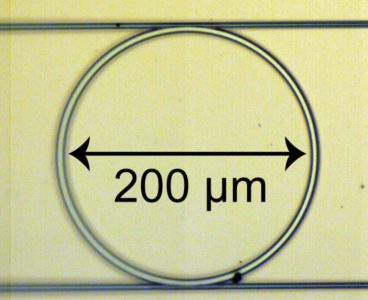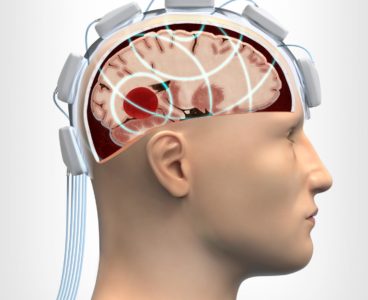Hydrogen is a clean and renewable energy carrier that can power vehicles, with water as the only emission. Unfortunately, hydrogen gas is highly flammable when mixed with air, so very efficient and effective sensors are needed. Now, researchers from Chalmers University of Technology, Sweden, present the first hydrogen sensors ever to meet the future performance…
World’s Fastest Hydrogen Sensor Could Pave the Way For Clean Hydrogen Energy
Hydrogen is a clean and renewable energy carrier that can power vehicles, with water as the only emission. Unfortunately, hydrogen gas is highly flammable when mixed with air, so very efficient and effective sensors are needed. Now, researchers from Chalmers University of Technology, Sweden, present the first hydrogen sensors ever to meet the future performance…
Breakthrough Could Double Efficiency of Organic Electronics
Researchers from Chalmers University of Technology in Sweden have discovered a simple new tweak that could double the efficiency of organic electronics. OLED-displays, plastic-based solar cells and bioelectronics are just some of the technologies that could benefit from their new discovery, which deals with “double-doped” polymers. The majority of our everyday electronics are based on…
Organic Food Worse for the Climate
Organically farmed food has a bigger climate impact than conventionally farmed food, due to the greater areas of land required. This is the finding of a new international study involving Chalmers University of Technology, Sweden, published in the journal Nature. The researchers developed a new method for assessing the climate impact from land-use, and used this,…
Removing Toxic Mercury From Contaminated Water
Water which has been contaminated with mercury and other toxic heavy metals is a major cause of environmental damage and health problems worldwide. Now, researchers from Chalmers University of Technology, Sweden, present a totally new way to clean contaminated water, through an electrochemical process. The results are published in the scientific journal Nature Communications. “Our results…
Understanding Catalysts at the Atomic Level can Provide a Cleaner Environment
By studying materials down to the atomic level, researchers at Chalmers University of Technology, Sweden, have found a way to make catalysts more efficient and environmentally friendly. The results have been published in Nature Communications. The methods can be used to improve many different types of catalysts. Catalysts are materials which cause or accelerate chemical…
New Innovation Improves the Diagnosis of Dizziness
Half of over-65s suffer from dizziness and problems with balance. But some tests to identify the causes of such problems are painful and can risk hearing damage. Now, researchers from Chalmers University of Technology, Sweden, have developed a new testing device using bone conduction technology, that offers significant advantages over the current tests. Hearing and…
A New Theory for Phantom Limb Pain Points the Way to More Effective Treatment
Phantom limb pain is a poorly understood phenomenon, in which people who have lost a limb can experience severe pain, seemingly located in that missing part of the body. The condition can be seriously debilitating and can drastically reduce the sufferer’s quality of life. But current ideas on its origins cannot explain clinical findings, nor…
Graphene Assembled Film Shows Higher Thermal Conductivity Than Graphite Film
Researchers at Chalmers University of Technology, Sweden, have developed a graphene assembled film that has over 60 percent higher thermal conductivity than graphite film – despite the fact that graphite simply consists of many layers of graphene. The graphene film shows great potential as a novel heat spreading material for form-factor driven electronics and other…
Graphene is Hot, Hot, Hot
Researchers at Chalmers University of Technology have developed a graphene assembled film that has over 60 percent higher thermal conductivity than graphite film — despite the fact that graphite simply consists of many layers of graphene. The graphene film shows great potential as a novel heat spreading material for form-factor driven electronics and other high…
Multiple Lasers Could Be Replaced by a Single Microcomb
Every time we send an e-mail, a tweet, or stream a video, we rely on laser light to transfer digital information over a complex network of optical fibers. Dozens of high-performance lasers are needed to fill up the bandwidth and to squeeze in an increasing amount of digital data. Researchers have now shown that all…
Flares in the Universe Can Now Be Studied on Earth
Solar flares, cosmic radiation, and the northern lights are well known phenomena. But exactly how their enormous energy arises is not as well understood. Now, physicists at Chalmers University of Technology, Sweden, have discovered a new way to study these spectacular space plasma phenomena in a laboratory environment. The results have been published in the…
Layer of Graphene Kills Bacteria on Implants
A tiny layer of graphene flakes becomes a deadly weapon and kills bacteria, stopping infections during procedures such as implant surgery. This is the findings of new research from Chalmers University of Technology in Sweden, recently published in the scientific journal Advanced Materials Interfaces. Operations for surgical implants, such as hip and knee replacements or…
Fabric Turns Kinetic Energy into Electricity
Working up a sweat from carrying a heavy load? That is when the textile works at its best. Researchers at Chalmers University of Technology have developed a fabric that converts kinetic energy into electric power, in cooperation with the Swedish School of Textiles in Borås and the research institute Swerea IVF. The greater the load…
Lasers Offer New Evidence That Light Stops Electrons
Whenever light hits an object, some of the light scatters back from the surface of the object. However, if the object is moving extremely fast, and if the light is incredibly intense, strange things can happen. Electrons, for example, can be shaken so violently that they actually slow down because they radiate so much energy.…
New Method Maps Chemicals in the Skin
A new method of examining the skin can reduce the number of animal experiments while providing new opportunities to develop pharmaceuticals and cosmetics. Chemical imaging allows all layers of the skin to be seen and the presence of virtually any substance in any part of the skin to be measured with a very high degree…
New Antibiotic Resistance Genes Found
Graphene, Other Nanomaterials Replace Scarce Metals
Graphene and Other Carbon Nanomaterials Can Replace Scarce Metals
Scarce metals are found in a wide range of everyday objects around us. They are complicated to extract, difficult to recycle and so rare that several of them have become “conflict minerals” which can promote conflicts and oppression. A survey at Chalmers University of Technology now shows that there are potential technology-based solutions that can…
The Spin in Graphene Can Be Switched Off
By combining graphene with another two-dimensional material, researchers at Chalmers University of Technology have created a prototype of a transistor-like device for future computers, based on what is known as spintronics. Spin as the information carrier can result in electronics that are significantly faster and more energy efficient. It can also lead to more versatile…
Deceleration of Runaway Electrons Paves the Way for Fusion Power
Fusion power has the potential to provide clean and safe energy that is free from carbon dioxide emissions. However, imitating the solar energy process is a difficult task to achieve. Two young plasma physicists at Chalmers University of Technology have developed a technology model that could lead to better methods for decelerating runaway electrons that…
Nanoalloys 10 Times as Effective as Pure Platinum in Fuel Cells
A new type of nanocatalyst can result in the long-awaited commercial breakthrough for fuel cell cars. Research results from Chalmers University of Technology and Technical University of Denmark show that it is possible to significantly reduce the need for platinum, a precious and rare metal, by creating a nanoalloy using a new production technique. The…
Fungi Have Enormous Potential for New Antibiotics
Fungi are a potential goldmine for the production of pharmaceuticals. This is shown by researchers at Chalmers University of Technology, who have developed a method for finding new antibiotics from nature’s own resources. The findings – which could prove very useful in the battle against antibiotic resistance – were recently published in the journal, Nature Microbiology.…
Microwave Helmet Yields Fast and Safe Evaluation of Head Injuries
Results from a clinical study demonstrates that microwave measurements can be used for a rapid detection of intracranial bleeding in traumatic brain injuries. A recently published scientific paper shows that health care professionals get vital information and can quickly decide on appropriate treatment if patients are examined using a microwave helmet. The study demonstrates a…
New Ion-Taming Technique Revolutionizes Health Care
A group of researchers at Chalmers University of Technology has discovered a completely new way of using lasers to accelerate ion beams. In time, the new technique could possibly give more people access to advanced cancer treatment. The results were recently published in the high impact journal Physical Review Letters. Advanced ion technology may in…


















